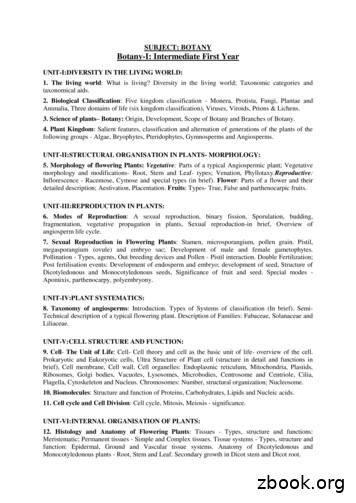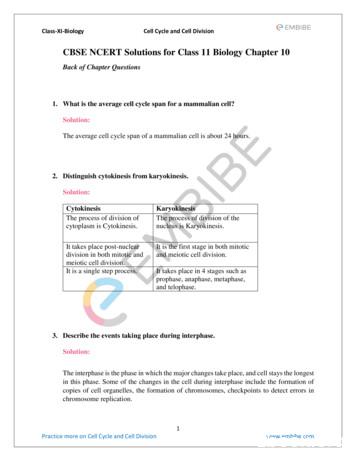Chapter 7 Cell Structure - Mr. C - Biology
07 Cell StructureOctober 17, 2013Chapter 7 Cell StructureMr. C. Biology1
07 Cell StructureOctober 17, 2013Chapter 7 Cell StructureAll living things are made of cells.Cells are made up of 3 main parts,Cell Membrane A skin that controls what enters the cell.Cytoplasm Watery substance that has proteins and sugar.Nucleus the control centre of the cell. It contains DNA.Cell MembraneNucleusCytoplasmMr. C. Biology2
07 Cell StructureOctober 17, 2013Plant Cells and Animal CellsMr. C. BiologyCell Wall ProtectionNo Cell WallChloroplasts make foodNo ChloroplastsLarge Vacuole store food/wasteSmall Vacuoles3
07 Cell StructureOctober 17, 2013Plant CellsThese cells are usually rectangular in shape.They have a large centralvacuole and have green Chloroplasts.Chloroplasts are small factories that make food.They catch sunlight and mix it with carbon dioxide and water to turn it into sugar.Chlorophyll is the green pigment (chemical) in the chloroplast that catches sunlight.An example of a plant cell is the onion cell (withIodine stain).Cell WallNucleusCytoplasmMr. C. Biology4
07 Cell StructureOctober 17, 2013MicroscopeA compound microscope uses 2 lenses.The eyepiece lens and the objectivelens powers are multiplied to give a totalmagnification.e.g. 10x by 40x 400xThe first person to discovermicroscopic life was a Dutch man calledAntonie van Leeuwenhoek.In 1665 Robert Hooke first usedthe word 'Cell'.Cells are measured inmicrometersThe symbol µm is used.There are 1000 micrometers in 1mm.An animal cell is about 25µm in length.Mr. C. Biology5
07 Cell StructureOctober 17, 2013Mandatory ExperimentTo prepare a slide from plant tissue and sketch the cellsMr. C. Biology6
07 Cell StructureOctober 17, 2013ResultsWith no stain it is difficult to see the cells.Onion CellThe onion cell is stained with Iodine.The cell wall and the nucleus are visible and yellow/brown.No chloroplasts or vacuoles.Animal CellThe cheek cell is stained with Methylene Blue.The nucleus is dark blue and the cytoplasm is light blue.Mr. C. Biology7
07 Cell StructureOctober 17, 2013Cell UltrastructureThis is the fine detail of the cell seen by an Electron Microscope.The membrane is made of aphospholipid and a protein.The phospholipids have a water loving and water hating end.Water Loving PhosphateWater Hating LipidsThe lipids keep away from theoutside and the phosphates stayon the outside. This keeps themembrane together.Functions1. Membranes retain the cell contents.2. Membranes control what enters and leaves the cell.3. Membranes recognise molecules that touch them.Mr. C. Biology8
07 Cell StructureOctober 17, 2013NucleusContains strands of DNA (Deoxyribonucleic Acid) called chromosomes.Humans have 46 chromosomes with about 25,000 genes.The chromosomes are usually found as Chromatin.Genes make an enzyme which control a function in the body.Nuclear pores allow RNA to travel out into the cytoplasm.NucleolusThis is where ribosomes are made. Ribosomes make proteins for the cell.MitochondriaThese are the energy factories for the cell and the whole organism.Mitochondria have their own DNA and are passed on only from the mother.Respiration (Food OxygenEnergy) happens in the mitochondria.The more infoldings a mitochondria has the more energy it makes.When you are sick your mitochondria have less infoldings, so you feel weak.As you get better the infoldings increase and you get more energy.Mr. C. Biology9
07 Cell StructureOctober 17, 2013ChloroplastsChloroplasts make glucose. They do this by catching sunlight in agreen pigment called Chlorophyll. The energy from the sunlight ismixed with CO2 and H2O to make C6H12 O6, which is stored as starch.Chloroplasts have their own DNA, which means they were once aseparate living thing from plants.Mr. C. Biology10
07 Cell StructureOctober 17, 2013Prokaryotes and EukaryotesWhat's the difference?Prokaryotic cells have no nucleus or membrane enclosed organelles.They are single celled, such as bacteria and monera.DNA is found in a loop.Eukaryotic cells have a nucleus and membrane enclosed organelles.They are multi celled and evolved from prokaryotes around 3 billionyears ago.Mr. C. Biology11
07 Cell Structure Mr. C. Biology 2 October 17, 2013 Chapter 7 Cell Structure All living things are made of cells. Cells are made up of 3 main parts, Cell Membrane A skin that controls what enters the cell. Cytoplasm Watery substance that has proteins and sugar.
Part One: Heir of Ash Chapter 1 Chapter 2 Chapter 3 Chapter 4 Chapter 5 Chapter 6 Chapter 7 Chapter 8 Chapter 9 Chapter 10 Chapter 11 Chapter 12 Chapter 13 Chapter 14 Chapter 15 Chapter 16 Chapter 17 Chapter 18 Chapter 19 Chapter 20 Chapter 21 Chapter 22 Chapter 23 Chapter 24 Chapter 25 Chapter 26 Chapter 27 Chapter 28 Chapter 29 Chapter 30 .
TO KILL A MOCKINGBIRD. Contents Dedication Epigraph Part One Chapter 1 Chapter 2 Chapter 3 Chapter 4 Chapter 5 Chapter 6 Chapter 7 Chapter 8 Chapter 9 Chapter 10 Chapter 11 Part Two Chapter 12 Chapter 13 Chapter 14 Chapter 15 Chapter 16 Chapter 17 Chapter 18. Chapter 19 Chapter 20 Chapter 21 Chapter 22 Chapter 23 Chapter 24 Chapter 25 Chapter 26
UNIT-V:CELL STRUCTURE AND FUNCTION: 9. Cell- The Unit of Life: Cell- Cell theory and cell as the basic unit of life- overview of the cell. Prokaryotic and Eukoryotic cells, Ultra Structure of Plant cell (structure in detail and functions in brief), Cell membrane, Cell wall, Cell organelles: Endoplasmic reticulum, Mitochondria, Plastids,
DEDICATION PART ONE Chapter 1 Chapter 2 Chapter 3 Chapter 4 Chapter 5 Chapter 6 Chapter 7 Chapter 8 Chapter 9 Chapter 10 Chapter 11 PART TWO Chapter 12 Chapter 13 Chapter 14 Chapter 15 Chapter 16 Chapter 17 Chapter 18 Chapter 19 Chapter 20 Chapter 21 Chapter 22 Chapter 23 .
of the cell and eventually divides into two daughter cells is termed cell cycle. Cell cycle includes three processes cell division, DNA replication and cell growth in coordinated way. Duration of cell cycle can vary from organism to organism and also from cell type to cell type. (e.g., in Yeast cell cycle is of 90 minutes, in human 24 hrs.)
Many scientists contributed to the cell theory. The cell theory grew out of the work of many scientists and improvements in the . CELL STRUCTURE AND FUNCTION CHART PLANT CELL ANIMAL CELL . 1. Cell Wall . Quiz of the cell Know all organelles found in a prokaryotic cell
Class-XI-Biology Cell Cycle and Cell Division 1 Practice more on Cell Cycle and Cell Division www.embibe.com CBSE NCERT Solutions for Class 11 Biology Chapter 10 Back of Chapter Questions 1. What is the average cell cycle span for a mammalian cell? Solution: The average cell cycle span o
Jan 21, 2020 · pertaining to the cell theory, structure and functions, cell types and modifications, cell cycle and transport mechanisms. This module has seven (7) lessons: Lesson 1- Cell Theory Lesson 2- Cell Structure and Functions Lesson 3- Prokaryotic vs Eukaryotic Cells Lesson 4- Cell Types and Cell























